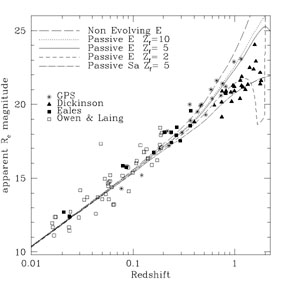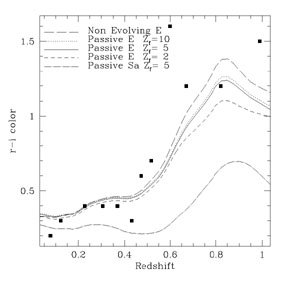


8.4. Absolute Magnitudes and the Hubble Diagram
Work in progress by Gelderman and collaborators will eventually allow accurate magnitudes to be obtained for CSS sources. This section concentrates on recent work on the GPS host galaxies by O'Dea et al. (1996a).
The absolute magnitudes in the Cousins RC band are between -22 and -24.0 (which corresponds to the range from M* to 2 mag brighter). This range of absolute magnitudes is consistent with the host galaxies of other powerful radio galaxies (see, e.g., Owen & Laing 1989; Owen & White 1991; Smith & Heckman 1989b) and first-ranked cluster galaxies (Postman & Lauer 1995). Thus, the distribution of optical absolute magnitudes is at least consistent with these sources being the progenitors of the large-scale radio sources. Note, however, that examination of the Rc Hubble diagram below does reveal differences between the GPS and 3CR host galaxies.
Figure 18 shows the Rc band
Hubble diagram for both the GPS sources and powerful extended
radio galaxies (mostly from 3CR). The GPS Hubble diagram has been
discussed by
Stanghellini (1992),
de Vries (1995),
Snellen et al. (1996b),
and
O'Dea et al. (1996a).
The good agreement between
the GPS and extended radio galaxies (especially at z
 0.5) suggests
that to first order the host galaxies of the GPS sources and extended
sources are essentially the same. However, there is a suggestion that at
redshifts of order unity the 3CR galaxies are brighter by about 1 mag
than the GPS galaxies. In addition,
O'Dea et al. (1996a)
show that the GPS galaxies
have a steeper slope than the sample as a whole. Since the 3CR galaxies
are now completely identified, the offset in magnitude is due not to
incompleteness in the 3CR.
0.5) suggests
that to first order the host galaxies of the GPS sources and extended
sources are essentially the same. However, there is a suggestion that at
redshifts of order unity the 3CR galaxies are brighter by about 1 mag
than the GPS galaxies. In addition,
O'Dea et al. (1996a)
show that the GPS galaxies
have a steeper slope than the sample as a whole. Since the 3CR galaxies
are now completely identified, the offset in magnitude is due not to
incompleteness in the 3CR.
 |
 |
Figure 18. (a) The Cousins RC band Hubble diagram for powerful radio galaxies. Magnitudes are not K-corrected. GPS galaxies are represented by asterisks, extended radio galaxies from Owen & Laing (1989) by open squares, 3CR galaxies from Eales (1985) by solid squares, and 3CR galaxies from Dickinson (1995, private communication) by solid triangles. Includes models from Bruzual & Charlot (1993). The key for the models is as follows: Long-dashed curve, nonevolving E galaxy; dotted curve, E galaxy with zf = 10; solid curve, E galaxy with zf = 5; short-dashed curve, E galaxy with zf = 2; dotted-long-dashed line, Sa galaxy with zf = 5. All models assume H0 = 75 and q0 = 0.1. (b) r - i color vs. redshift for GPS host galaxies. The key to the plotted models is as follows: Long-dashed curve, nonevolving E galaxy; dotted curve, E galaxy with zf = 10; solid curve, E galaxy with zf = 5; short-dashed curve, E galaxy with zf = 2; dotted-long-dashed line, Sa galaxy with zf = 5. All models assume H0 = 75 and q0 = 0.1. Adapted from O'Dea et al. (1996a). |
One possibility is that the extra light in the 3CR galaxies could be related to radio power - i.e., if the 3CR galaxies are stronger radio sources, then they may have more of the extra component. O'Dea et al. (1996a) showed that there are no systematic differences between the GPS and 3CR galaxies regarding the relationship between optical magnitude and radio power. Thus, the result that, at high redshift, the 3CR galaxies are brighter than the GPS galaxies is not due to the 3CR galaxies having more powerful radio sources.
O'Dea et al. compared the data with models computed with the latest
version of the Bruzual-Charlot population synthesis code (described by
Charlot, Worthey, &
Bressan 1996)
assuming a single 0.5 Gyr duration burst of star formation at some
formation redshift zf, followed by "passive"
evolution. The models are normalized in magnitude to the data at low
redshift. The "no evolution" model is that for an average elliptical at
age 13.5 Gyr (see Fig. 5 of
Bruzual & Charlot
1993).
Figure 18 shows that the GPS galaxies are
consistent with both the nonevolving elliptical model and passive
evolution of an old stellar population (zf
 5). Models in
which the stellar populations are younger (the elliptical model with
zf = 2 and the Sa model with
zf = 5) tend to be brighter than the GPS
sources at redshifts z
5). Models in
which the stellar populations are younger (the elliptical model with
zf = 2 and the Sa model with
zf = 5) tend to be brighter than the GPS
sources at redshifts z
 1. The 3CR galaxies
at z
1. The 3CR galaxies
at z  1 are
brighter than predicted by these passive evolution models with an old
stellar population (cf.
Spinrad 1986;
Spinrad & Djorgovski
1987;
Djorgovski 1987).
The fact that the GPS galaxies agree with the models for passive
evolution of old stellar populations suggests that difference between
the GPS and 3CR galaxies is not due to the GPS galaxies being redder
than normal elliptical galaxies, but to the 3CR galaxies being bluer
than normal elliptical galaxies. This is also consistent with the
observed agreement of the GPS sources with the 3CR on the K-band
Hubble diagram
(de Vries et al. 1998b).
1 are
brighter than predicted by these passive evolution models with an old
stellar population (cf.
Spinrad 1986;
Spinrad & Djorgovski
1987;
Djorgovski 1987).
The fact that the GPS galaxies agree with the models for passive
evolution of old stellar populations suggests that difference between
the GPS and 3CR galaxies is not due to the GPS galaxies being redder
than normal elliptical galaxies, but to the 3CR galaxies being bluer
than normal elliptical galaxies. This is also consistent with the
observed agreement of the GPS sources with the 3CR on the K-band
Hubble diagram
(de Vries et al. 1998b).
As discussed above, the GPS sources are missing the blue aligned component that is seen in larger scale radio galaxies. This lack of a blue component may be responsible for their different behavior on the Hubble diagram (see also Snellen et al. 1996b). One consequence of this is that the stellar evolution of GPS galaxies may be simpler than the 3CR galaxies with large-scale radio sources. Thus, the "optically boring" GPS galaxies may provide examples of "normal" giant elliptical galaxies at high redshift (Snellen et al. 1996b; O'Dea et al. 1996a; Bremer & Snellen 1996).